Physical Address
304 North Cardinal St.
Dorchester Center, MA 02124
Introduction to [CR] , Surgical Anatomy and Monitoring of the Superior Laryngeal Nerve.
Superior Laryngeal Nerve Anatomy and Monitoring.
Stimulation of the Right-Sided External Branch of the Superior Laryngeal Nerve During Thyroidectomy.
The technical aspects of operations on the thyroid gland have changed very little since the original papers by Kocher. Usually, the complication rate of thyroidectomy is very low when an experienced surgeon performs the operation. The most common complications include hypoparathyroidism and injury of the recurrent laryngeal nerve (RLN). However, injury to the external branch of the superior laryngeal nerve (EBSLN) can occur during the dissection and control of the superior thyroid vessels. This injury causes paralysis of the cricothyroid muscle (CTM), impairing the production of high tones, and altering the voice’s fundamental frequency; this is especially problematic for individuals requiring vocal projection and professional singers. The effects of EBSLN paralysis are difficult to detect during routine postoperative laryngoscopy, yet functional consequences can be disastrous for those people who depend professionally on their voices. Armed with complete knowledge of the anatomic variations of the superior thyroid pole area, and through meticulous dissection of the superior thyroid pedicle, one may avoid such injury. In addition, this chapter will briefly discuss the use of the internal branch of the superior laryngeal nerve (IBSLN) to continuously monitor vocal fold function via the laryngeal adductor reflex (LAR).
In 1892, Fort reported the anatomic features of the CTM, including its motor supply by the EBSLN. Several publications have studied the anatomy of the EBSLN, generally in cadaver series. The largest report, by Moosman and DeWeese, included 200 fresh cadavers.
Little attention was paid initially to the surgical anatomy of the EBSLN during the beginning of the 20th century. In fact, even Kocher did not specifically mention this nerve in his book, which was once considered the cornerstone of thyroid surgery. Kocher’s book entitled “Surgical operations teaching manual” in a chaper “Indications and results in goiter operations” documented his personal experience with more than 3000 thyroidectomies. The importance of the preservation of the EBSLN was made clear as a result of a thyroidectomy performed in 1935. At that time, Amelita Galli-Curci was the most famous soprano of the world. She underwent a thyroidectomy for a 170-g goiter. The surgeon used local anesthesia and asked his patient to speak during the surgery to be sure that the RLNs incurred no damage. The surgeon made careful identification and preservation of the RLNs. However, Galli-Curci’s vocal registry dramatically lowered postoperatively, and her voice became permanently hoarse. She had to give up singing; the press of the time wrote, “the surprising voice is gone forever; the sad specter of a ghost replaced the velvet softness.” Since that time, the EBSLN has been known as “the nerve of Amelita Galli-Curci.” Interestingly enough, some authors have recently questioned the veracity of this event.
In 1957, Gregg stated that, despite the large experience of his service (8000 thyroidectomies), he was unsure how to prevent or detect damage to the EBSLN. Subsequently, several authors proposed that the dissection of the superior thyroid pole should be performed with great care to avoid including the nerve in the ligature of the superior thyroid vessels.
Some reports in the literature have described methods to identify the EBSLN during a thyroidectomy. Some authors have based their identification only upon the anatomic appearance of the nerve. Others have tried some form of electrical stimulation to aid in identification, mainly when dealing with markedly enlarged thyroid glands.
The superior laryngeal nerve (SLN) is one of the first branches of cranial nerve X (i.e., the vagus). It usually separates from the vagus at the nodose ganglion, which is about 4 cm cranially to the carotid artery bifurcation. About 1.5 cm inferiorly, the SLN divides in two branches: the IBSLN and EBSLN. The IBSLN descends within the carotid sheath posterior to the internal carotid artery before passing anteromedially to pierce the thyrohyoid membrane with the superior laryngeal artery. The IBSLN supplies sensation to the supraglottic larynx, piriform fossae, and valleculae. The EBSLN descends from behind the carotid vessels, extends from the vessels medially, and continues medially to the larynx. The nerve is usually about 0.8 mm wide, and its total length varies between 8.0 cm and 8.9 cm ( Figure 35.1 ). In 1968, Moosman and DeWeese defined the sternothyroid-laryngeal triangle (Joll’s space). The limits of Joll’s space are as follows: medially, the inferior pharyngeal constrictor and the CTM; anteriorly, the sternothyroid muscle; and laterally, the superior thyroid pole ( Figure 35.2 ). According to the anatomic study encompassing 200 cadaver dissections, the EBSLN almost invariably approached the larynx within this triangle.
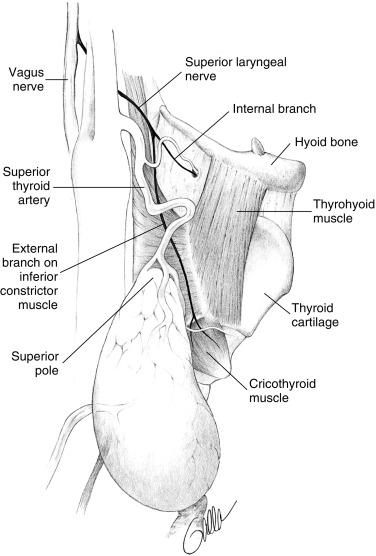
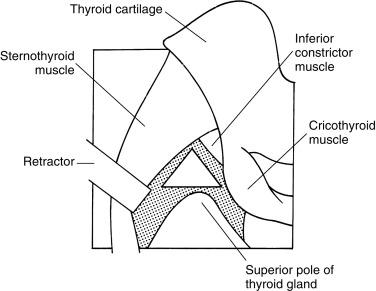
The surgical importance of this nerve relates to its proximity to the superior thyroid vessels. In most instances, the EBSLN crosses the superior thyroid artery and vein well above the superior border of the superior thyroid pole. At least in theory, the EBSLN is protected against surgical injuries; however, Droulias et al. reproduced the surgical conditions of a thyroidectomy in 24 cadavers. They clamped the superior thyroid pedicle adjacently to the superior thyroid pole and found that the nerve was entrapped in most situations. Clader, Luter, and Daniels dissected 48 cadavers and found that 68% of the EBSLNs were intimately associated with the superior pole vessels and were at risk during thyroidectomy. On the other hand, Espinoza, Hamoir, and Dehm and Lennquist, Cahlin, and Smeds noted lower rates of “at-risk” EBSLNs (15% and 18%, respectively). In addition, Lennquist, Cahlin, and Smeds stated that only 80% of the EBSLN could be identified during a thyroidectomy because, in the remaining 20%, the nerve was located within the fibers of the inferior pharyngeal constrictor muscle.
In a study, Wu et al. processed 27 human hemilarynges with Sihler’s stain, a technique that clears soft tissue and counterstains nerve. Of the 27 specimens, 44% had a neural connection that exited the medial surface of the CTM (on the outside of the larynx) and then entered into the larynx. The neural connection then extended through the cricothyroid membrane and ramified the anterior third the ipsilateral thyroarytenoid muscle (also known as the vocalis muscle in the endolarynx). Similar observations were made in the canine by Nasri et al. who identified cross-innervation of the thyroarytenoid muscle by the EBSLN in 42.9% of subjects. This was confirmed by electromyography (EMG) recordings from thyroarytenoid muscle that followed the electrical stimulation applied to the EBSLN. Sanudo et al. found that in 68% of 90 human microdissected specimens, the EBSLN (after innervating the CTM) continues on, extending through the cricothyroid membrane to innervate the anterior thyroarytenoid muscle region. Using microdissection technique in 103 human larynges obtained from necropsies, Maranillo et al. studied the existence of a neural connection between the external laryngeal nerve and the RLN. The human communicating nerve was identified in 85% of cases in this study (bilaterally in 44% and unilaterally in 41%). Masuoka et al. investigated the prevalence of functional innervation of the CTM by the RLN during 70 thyroid lobectomies in humans. Responses after stimulation of unilateral vagal and RLN were evaluated in this study by visual observation of the CTM twitch and by EMG through needle electrodes inserted into the CTM. The RLN stimulation resulted in possible CTM contractions and clear electromyographic responses (> 300 μV) in 39%, either response in 34%, and neither response in 27% of the CTMs. These findings have been questioned by subsequent electrophysiologic studies; the later studies suggest that although the EBSLN may innervate the vocal cord through the human communicating nerve, the RLN does not innervate the CTM. Thus the human communicating nerve provides documented connection to the to the vocal fold in 41% to 85% of patients. The variability of this neural connection, variability in recording the small and early glottic waveform associated with EBSLN stimulation, and variability in endotracheal tube position are all likely responsible for defined waveforms being recordable in fewer than 100% of patients during EBSLN stimulation (using currently available standard monitoring technology). However, use of a novel endotracheal tube with additional anterior surface electrodes allows for quantifiable EBSLN electromyographic activity in 100% of cases. Monopolar and bipolar stimulator probes produced similar electromyographic data.
There are few surgical classifications of the EBSLN anatomic variations. However, the most widely recognized surgical classification of the EBSLN was proposed in 1992 by Cernea et al. This classification is based on the potential risk of injury to the nerve during thyroid surgery. It categorizes the nerve in relation to superior thyroid vessels and the upper edge of the superior thyroid pole ( Figure 35.3 ).
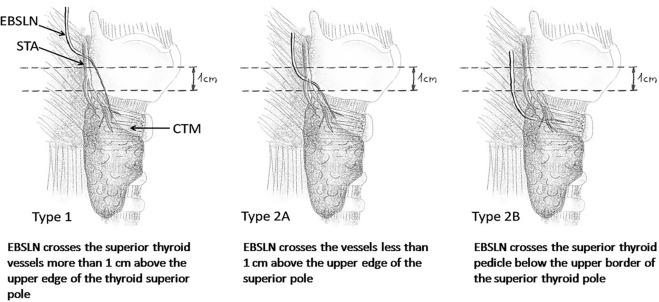
Type 1. Nerve crosses the superior thyroid vessels more than 1 cm above the upper edge of the thyroid superior pole and occurs in 68% of patients with small goiter and in 23% of patients with large goiter.
Type 2A. Nerve crosses the vessels less than 1 cm above the upper edge of the superior pole and occurs in 18% of patients with small goiter and 15% of patients with large goiter.
Type 2B. Nerve crosses the superior thyroid pedicle below the upper border of the superior thyroid pole and occurs in 14% of patients with small goiters and 54% of patients with large goiters.
Types 2A and 2B are particularly prone to injury during dissection and ligation of the superior thyroid vessels due to their low-lying course. It is of interest to note that most studies on the anatomy of EBSLN have been performed in Western countries. Hence studies may have some limitations in their application to other nations, particularly to patients in Asian countries. Hwang et al. investigated 92 EBSLNs during 50 thyroid operations performed on adult Korean patients in Seoul and found that type 1 EBSLN was observed in 15 of the 92 nerves (16.3%), type 2A EBSLN was noted in 52 (56.5%) and type 2B EBSLN was noted in 25 (27.2%). Patients with types 2A and 2B were at higher risk of injuries, and these types were more frequently observed (83.7%) compared with previous Western studies. It was also found that 35.9% of distal insertion sites of EBSLNs were located within 1 cm of the center of the cricoid cartilage.
In 1998, Kierner et al. published a similar classification; however, they added a fourth category in which the EBSLN runs dorsally to the superior thyroid pedicle, making its identification more difficult. They observed this anatomic relationship in 13% of their dissections. They observed fewer type 1 nerves (42%) than in the Cernea series ( Figure 35.4 ).
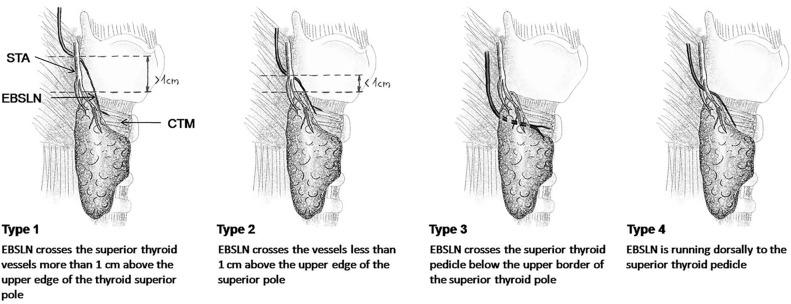
Type 1. Nerve crosses the superior thyroid vessels more than 1 cm above the upper edge of the thyroid superior pole.
Type 2. Nerve crosses the vessels less than 1 cm above the upper edge of the superior pole.
Type 3. Nerve crosses the superior thyroid pedicle below the upper border of the superior thyroid pole.
Type 4. Nerve runs dorsally to the superior thyroid pedicle.
In 2002, Friedman et al. proposed a different classification for the EBSLN that focuses on the relationship between the nerve and the inferior constrictor at its junction with the CTM. Based on their experience with 1057 nerves exposed in 884 patients, they were able to identify and to classify 900 (85.1%) of the nerves. Friedman’s classification system was not intended to replace the classification system proposed by Cernea et al. In contrast, it should be considered as a complementary classification system, useful for intraoperative identification of the nerve. Three variations have been described by Friedman et al. for the main trunk of the EBSLN before its terminal branching ( Figure 35.5 ).
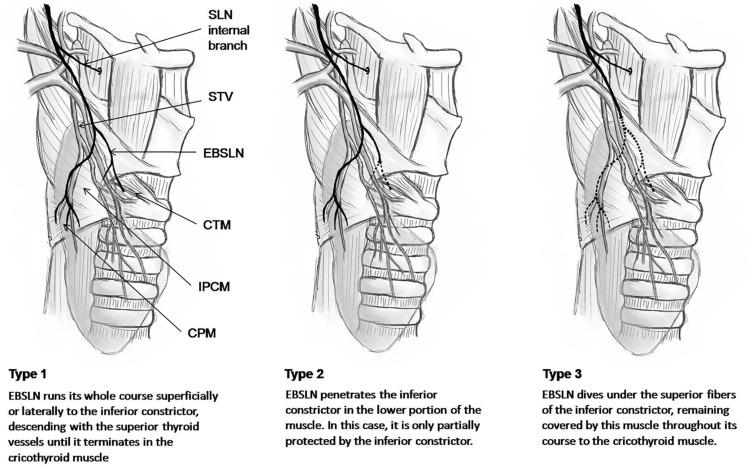
Become a Clinical Tree membership for Full access and enjoy Unlimited articles
If you are a member. Log in here